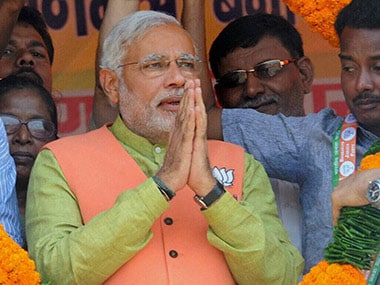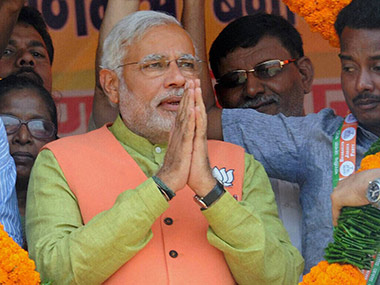If Narendra Modi drives into 7 Race Course Road next week, he will have to thank the Hindi heartland. On the campaign trail he had said “Yeh Dil Maange More” in an appeal to voters to elect him with a comfortable majority. If the CNN-IBN-CSDS post poll survey is correct, the Hindi-speaking belt of North India has responded emphatically to the man from Gujarat. In the heartland states where the BJP is in a bipolar contest with the Congress, i.e. Rajasthan, Madhya Pradesh, Chhattisgarh, Uttarakhand and Himachal Pradesh it is predicted to win handsomely, with near clean sweeps in all of them. In these heartland states, it is difficult to distinguish the Modi wave from the anti-Congress wave. The more keenly fought battles were always going to be in Uttar Pradesh and Bihar (a massive 120 Lok Sabha seats between them), states with a multi-polar polity and complex social structures/cleavages which were never going to be a straight-forward Congress-BJP battle. The message from these states in the post poll survey results suggests a strong Modi wave. In Uttar Pradesh, the BJP is forecast to corner 40 percent of the vote (up from 18 percent in 2009), 16 percentage points ahead of its nearest rival, the Samajwadi Party which is set to score 24 percent. In seats, that translates into near 50 for the BJP, approximating its sweep of the state in 1998. The caste coalition supporting the BJP is interesting. [caption id=“attachment_1520387” align=“alignleft” width=“380”]
 Has a Modi wave benefitted the BJP in the Hindi heartland. PTI[/caption] The party has drawn support from its traditional vote-bank, the upper castes. But it has also registered solid support among non-Yadav OBCs (Yadav’s are with Mulayam) and Non-Jatava Scheduled Castes (Jatava SCs are with Mayawati). Modi’s leadership has succeeding in poaching voters from castes that traditionally voted for either Mulayam Singh Yadav or Mayawati en bloc. Whether this is more because of a “Hindu consolidation” or whether it is largely because of Modi’s OBC credentials or whether it is because his pitch for development has made an impact among these deprived sections is something that would need detailed study. It is likely to be some combination of all three, but the fact is that Modi’s presence is the explanation behind all three factors. Significantly, the Samajwadi Party has actually retained the same percentage of vote it won in 2009. However, the Muslim vote hasn’t entirely consolidated behind it. While Mulayam’s party has the support of a majority of UP’s Muslims, the BSP and Congress are also picking up not insignificant shares. That is powering Modi towards the 50 seat mark. The message from Bihar is only slightly different. There is an unprecedented upper caste consolidation in favour of the BJP but there are also significant numbers of non-Yadav OBCs and Dalits who are supporting the BJP. Again, a combination of soft Hindutva, a pitch for development and Modi’s own OBC credentials (plus humble beginnings) have lifted the BJP in the state. Where Bihar is different from UP is the greater consolidation of the Yadav and Muslim vote in favour of the Congress-RJD alliance. Nitish Kumar’s calculation of winning the Muslim vote after parting ways with Modi has not worked. The minority community is solidly behind his nemesis Lalu Yadav who is expected to do reasonably well, winning up to 15 seats in alliance with the Congress. The Modi factor is also playing a major role in Delhi, Haryana and Jharkhand, states where there are three-cornered contests. In Delhi, the Modi-effect has helped the BJP stave off the AAP challenge, with Kejriwal’s party only expected to win one seats out of seven. In Haryana, a state where the BJP hasn’t traditionally been strong because the dominant Jat votes have divided between Congress and INLD, it is registering a strong performance in alliance with the Haryana Janhit Congress, a party with an OBC (but not Jat) base. On Friday, 16 May, India will find out whether the Hindi heartland has delivered its most radical electoral verdict in the last 25 years, since VP Singh was swept to power in 1989.
Has a Modi wave benefitted the BJP in the Hindi heartland. PTI[/caption] The party has drawn support from its traditional vote-bank, the upper castes. But it has also registered solid support among non-Yadav OBCs (Yadav’s are with Mulayam) and Non-Jatava Scheduled Castes (Jatava SCs are with Mayawati). Modi’s leadership has succeeding in poaching voters from castes that traditionally voted for either Mulayam Singh Yadav or Mayawati en bloc. Whether this is more because of a “Hindu consolidation” or whether it is largely because of Modi’s OBC credentials or whether it is because his pitch for development has made an impact among these deprived sections is something that would need detailed study. It is likely to be some combination of all three, but the fact is that Modi’s presence is the explanation behind all three factors. Significantly, the Samajwadi Party has actually retained the same percentage of vote it won in 2009. However, the Muslim vote hasn’t entirely consolidated behind it. While Mulayam’s party has the support of a majority of UP’s Muslims, the BSP and Congress are also picking up not insignificant shares. That is powering Modi towards the 50 seat mark. The message from Bihar is only slightly different. There is an unprecedented upper caste consolidation in favour of the BJP but there are also significant numbers of non-Yadav OBCs and Dalits who are supporting the BJP. Again, a combination of soft Hindutva, a pitch for development and Modi’s own OBC credentials (plus humble beginnings) have lifted the BJP in the state. Where Bihar is different from UP is the greater consolidation of the Yadav and Muslim vote in favour of the Congress-RJD alliance. Nitish Kumar’s calculation of winning the Muslim vote after parting ways with Modi has not worked. The minority community is solidly behind his nemesis Lalu Yadav who is expected to do reasonably well, winning up to 15 seats in alliance with the Congress. The Modi factor is also playing a major role in Delhi, Haryana and Jharkhand, states where there are three-cornered contests. In Delhi, the Modi-effect has helped the BJP stave off the AAP challenge, with Kejriwal’s party only expected to win one seats out of seven. In Haryana, a state where the BJP hasn’t traditionally been strong because the dominant Jat votes have divided between Congress and INLD, it is registering a strong performance in alliance with the Haryana Janhit Congress, a party with an OBC (but not Jat) base. On Friday, 16 May, India will find out whether the Hindi heartland has delivered its most radical electoral verdict in the last 25 years, since VP Singh was swept to power in 1989.
Yeh Dil Maange More: Hindi heartland delivers India to Modi
Dhiraj Nayyar
• May 13, 2014, 09:12:40 IST
If Narendra Modi drives into 7 Race Course Road next week, he will have to thank the Hindi heartland.
Advertisement
)
End of Article